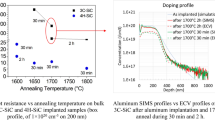Abstract
We examine the formation of Si1-xCx (x = 0.04–0.2) by means of CFy (y = 0,1,3) implantation in p-type Si, for application as a wide-bandgap emitter in a Si heterojunc-tion bipolar transistor. Upon implantation with 2.5 × 1016 CF+/cm2 at 45 keV, and subsequently with 2.5 × 1016 C+/cm2 at 30 keV, an amorphous top layer is formed. Annealing at temperatures up to 900 °C leads to a layer consisting of nanocrystalline material. High resolution transmission electron microscopy and secondary ion mass spectrometry show that a well-defined nanocrystalline/crystalline interface is created at an anneal temperature of 550 °C. At higher temperatures lattice defects start to develop. Preliminary attempts to dope the material via phosphorus or arsenic implantation indicate that temperatures of at least 900 °C are required to activate a fraction of the implanted dopants. This, however, adversely affects the adlayer/substrate interface.
Similar content being viewed by others
References
High Speed Semiconductor Devices, edited by S. M. Sze (John Wiley & Sons, New York, 1990), p. 366.
M. Kuwagaki, K. Imai, and Y. Amemiya, Jpn. J. Appl. Phys. 28, L754 (1989).
M. Kuwagaki, K. Imai, T. Ogino, and Y. Amemiya, Jpn. J. Appl. Phys. 28, L173 (1989).
T. Sugii, T. Yamazaki, Y. Arimoto, T. Ito, Y. Furumura, I. Namura, H. Goto, and A. Tahara, Microelectr. Eng. 19, 335 (1992), and references therein.
M. J. J. Theunissen, M. C. Martens, J. B. Clegg, D. E. W. Vandenhoudt, and P. C. Zalm, J. Electrochem. Soc. 142, 226 (1995).
K. J. Reeson, P. L. F. Hemment, J. Stoemenos, J. R. Davis, and G. K. A. Celler, Inst. Phys. Conf. Ser. No. 87, 427 (1987), in Silicon-on-Insulator and Buried Metals in Semiconductors, edited by J.C. Sturm, C. K. Chen, L. Pfeiffer, and P. L. F. Hemment (Mater. Res. Soc. Symp. Proc. 107, Pittsburgh, PA, 1988), p. 473.
P. Martin, B. Daunin, M. Dupuy, A. Ermolieff, M. Olivier, A. M. Papon, and G. Rolland, J. Appl. Phys. 67, 2908 (1990).
J. F. Ziegler, J.P. Biersack, and U. Littmark, The Stopping and Range of Ions in Solids (Pergamon Press, New York, 1985).
H. J. Ligthart and J. Politiek, Philips Tech. Rev. 43, 185 (1986).
R. G. Wilson, F. A. Stevie, and C. W. Magee, Secondary Ion Mass Spectrometry (John Wiley & Sons, New York, 1989).
L. J. van der Pauw, Philips Res. Rep. 13, 1 (1958).
P. A. Stolk, D. J. Eaglesham, H-J. Gossmann, and J. M. Poate, Appl. Phys. Lett. 66, 1370 (1995).
J. Kato, J. Electrochem. Soc. 137, 1918 (1990).
M. Seibt, J. Imschweiler, and H-A. Hefner, in Defect Engineering in Semiconductor Growth, Processing and Device Technology, edited S. Ashok, J. Chevallier, K. Sumino, and E. Weber (Mater. Res. Soc. Symp. Proc. 262, Pittsburgh, PA, 1992), p. 1103.
S. Mantl, Mater. Sci. Rep. 8, 1 (1992).
E. H. A. Dekempeneer, J. J. M. Ottenheim, D. E. W. Vandenhoudt, C. W. T. Bulle-Lieuwma, and E. G. C. Lathouwers, Nucl. Instrum. Methods B 55, 769 (1991).
Author information
Authors and Affiliations
Rights and permissions
About this article
Cite this article
Oostra, D.J., Politiek, J., Bulle-Lieuwma, C.W.T. et al. Can carbon-implanted silicon be applied as wide-bandgap emitter?. Journal of Materials Research 11, 1653–1658 (1996). https://doi.org/10.1557/JMR.1996.0207
Received:
Accepted:
Published:
Issue Date:
DOI: https://doi.org/10.1557/JMR.1996.0207




